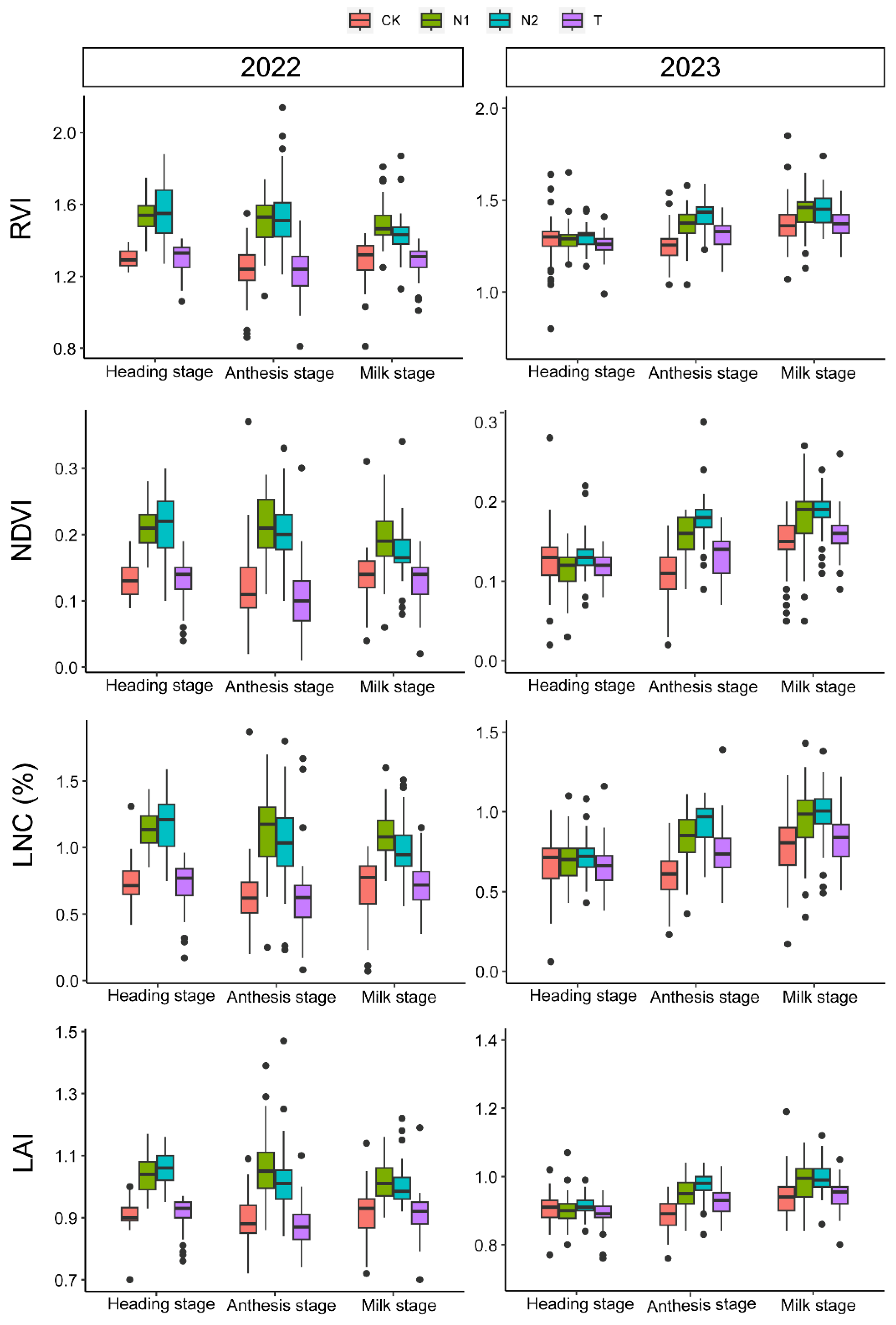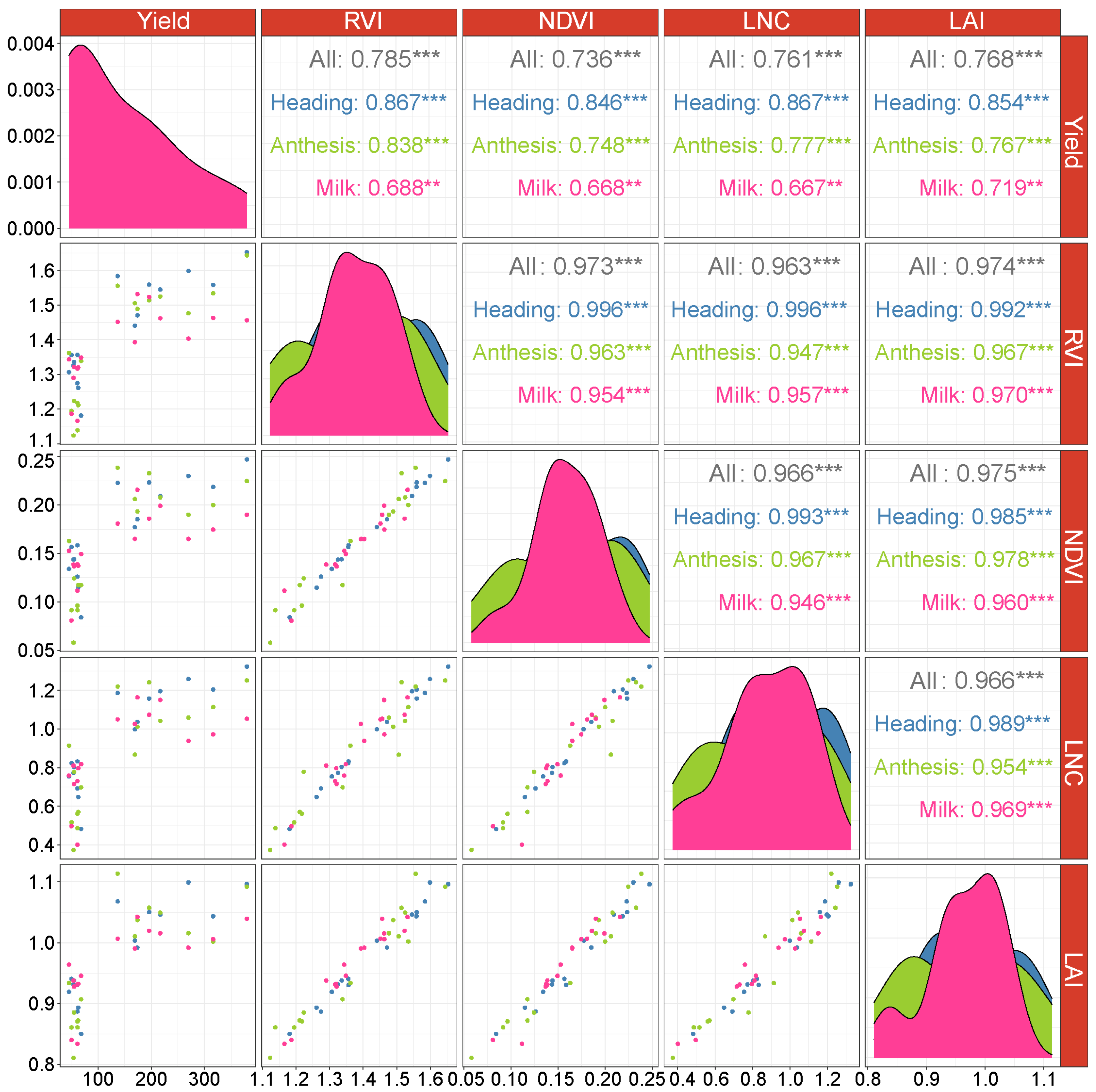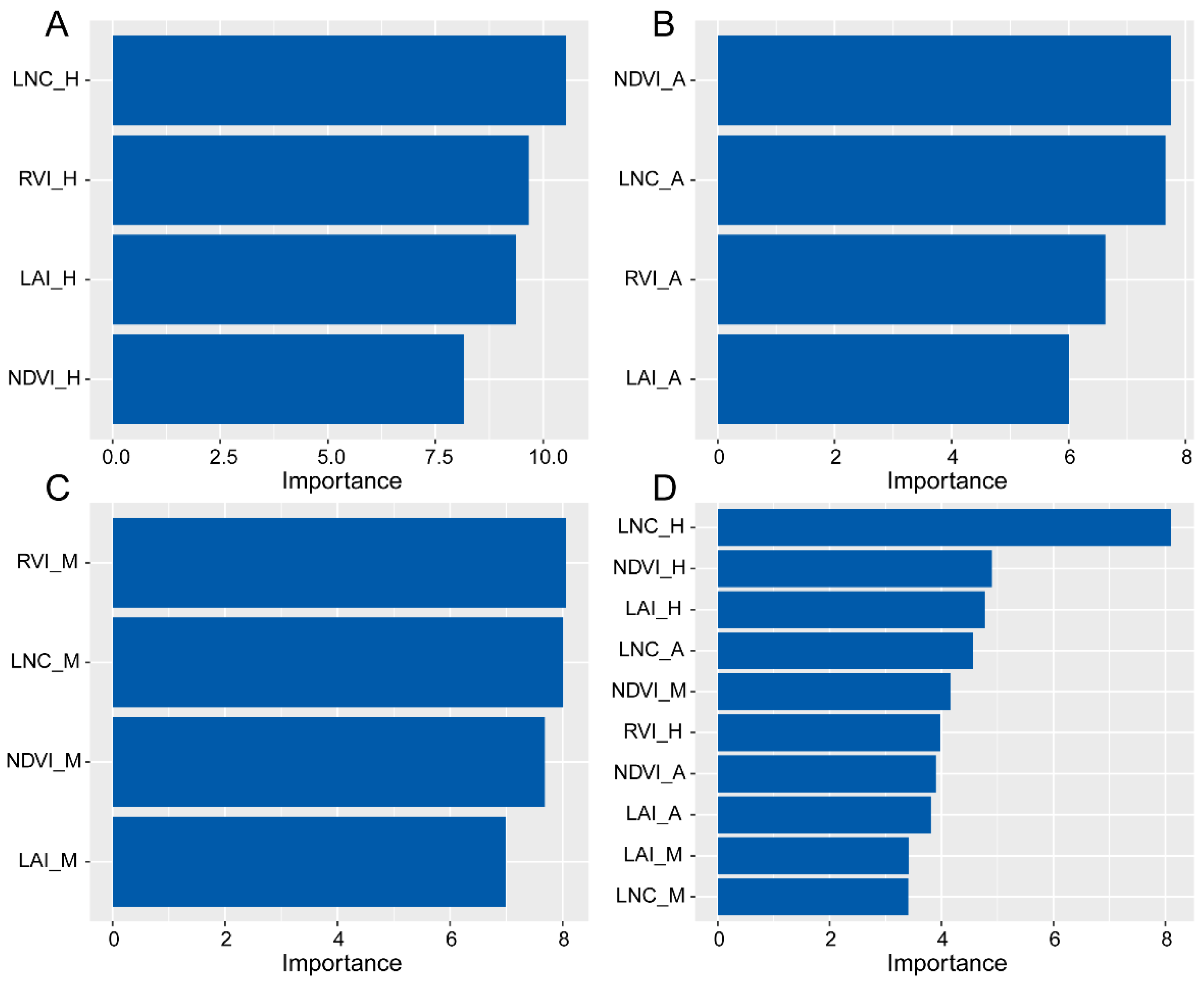Using Machine Learning Methods Combined with Vegetation Indices and Growth Indicators to Predict Seed Yield of Bromus inermis
Abstract
1. Introduction
2. Results
2.1. The Explanatory Analysis of Seed Yield Components, Vegetation Index, and Growth Parameters
2.2. Relationship between RVI, NDVI, LNC, LAI, and Seed Yield
2.3. Performance Assessment of Machine Learning Models for Predicting Seed Yield Based on RVI, NDVI, LNC, and LAI
3. Discussion
4. Materials and Methods
4.1. Experimental Field
4.2. Measurement of RVI, NDVI, LNC, and LAI
4.3. Measurement of Seed Yield and Yield Components
4.4. Seed Yield Prediction Methods
4.5. Data Analysis
5. Conclusions
Supplementary Materials
Author Contributions
Funding
Data Availability Statement
Acknowledgments
Conflicts of Interest
References
- Casler, M.D.; Vogel, K.P.; Balasko, J.A.; Berdahl, J.D.; Miller, D.A.; Hansen, J.L.; Fritz, J.O. Genetic progress from 50 years of smooth bromegrass breeding. Crop Sci. 2000, 40, 13–22. [Google Scholar] [CrossRef]
- Smart, A.J.; Schacht, W.H.; Volesky, J.D.; Moser, L.E. Seasonal changes in dry matter partitioning, yield, and crude protein of Iintermediate wheatgrass and smooth bromegrass. Agron. J. 2006, 98, 986–991. [Google Scholar] [CrossRef]
- Salesman, J.B.; Thomsen, M. Smooth brome (Bromus Inermis) in tallgrass prairies: A review of control methods and future research directions. Ecol. Restor. 2011, 29, 374–381. [Google Scholar] [CrossRef]
- Ou, C.; Wang, M.; Hou, L.; Zhang, Y.; Sun, M.; Sun, S.; Jia, S.; Mao, P. Responses of seed yield components to the field practices for regulating seed yield of smooth bromegrass (Bromus Inermis Leyss.). Agriculture 2021, 11, 940. [Google Scholar] [CrossRef]
- Hara, P.; Piekutowska, M.; Niedbała, G. Selection of independent variables for crop yield prediction using artificial neural network models with remote sensing data. Land 2021, 10, 609. [Google Scholar] [CrossRef]
- Niedbała, G.; Kurek, J.; Świderski, B.; Wojciechowski, T.; Antoniuk, I.; Bobran, K. Prediction of blueberry (Vaccinium Corymbosum L.) yield based on artificial intelligence methods. Agriculture 2022, 12, 2089. [Google Scholar] [CrossRef]
- Tian, Y.C.; Yao, X.; Yang, J.; Cao, W.X.; Hannaway, D.B.; Zhu, Y. Assessing newly developed and published vegetation indices for estimating rice leaf nitrogen concentration with ground- and space-based hyperspectral reflectance. Field Crops Res. 2011, 120, 299–310. [Google Scholar] [CrossRef]
- Fu, Y.; Yang, G.; Pu, R.; Li, Z.; Li, H.; Xu, X.; Song, X.; Yang, X.; Zhao, C. An overview of crop nitrogen status assessment using hyperspectral remote sensing: Current status and perspectives. Eur. J. Agron. 2021, 124, 126241. [Google Scholar] [CrossRef]
- Wang, D.; Li, R.; Liu, T.; Liu, S.; Sun, C.; Guo, W. Combining vegetation, color, and texture indices with hyperspectral parameters using machine-learning methods to estimate nitrogen concentration in rice stems and leaves. Field Crops Res. 2023, 304, 109175. [Google Scholar] [CrossRef]
- Zhang, J.; Liu, X.; Liang, Y.; Cao, Q.; Tian, Y.; Zhu, Y.; Cao, W.; Liu, X. Using a portable active sensor to monitor growth parameters and predict grain yield of winter wheat. Sensors 2019, 19, 1108. [Google Scholar] [CrossRef]
- Wu, J.B.; Matan, J.; Wei, Y.F.; Guo, K.Z.; Lian, X.W. Research on the changes of vegetation coverage in turks county based on NDVI. Appl. Mech. Mater. 2013, 409–410, 788–794. [Google Scholar] [CrossRef]
- Jakubauskas, M.E.; Legates, D.R.; Kastens, J.H. Crop identification using harmonic analysis of time-series AVHRR NDVI data. Comput. Electron. Agric. 2002, 37, 127–139. [Google Scholar] [CrossRef]
- Yao, Y.; Miao, Y.; Cao, Q.; Wang, H.; Gnyp, M.L.; Bareth, G.; Khosla, R.; Yang, W.; Liu, F.; Liu, C. In-season estimation of rice nitrogen status with an active crop canopy sensor. IEEE J. Sel. Top. Appl. Earth Obs. Remote Sens. 2014, 7, 4403–4413. [Google Scholar] [CrossRef]
- Sultana, S.R.; Ali, A.; Ahmad, A.; Mubeen, M.; Zia-Ul-Haq, M.; Ahmad, S.; Ercisli, S.; Jaafar, H.Z.E. Normalized difference vegetation index as a tool for wheat yield estimation: A case study from faisalabad, Pakistan. Sci. World J. 2014, 2014, 725326. [Google Scholar] [CrossRef]
- Teal, R.K.; Tubana, B.; Girma, K.; Freeman, K.W.; Arnall, D.B.; Walsh, O.; Raun, W.R. In-season prediction of corn grain yield potential using normalized difference vegetation index. Agron. J. 2006, 98, 1488–1494. [Google Scholar] [CrossRef]
- Pokhrel, A.; Virk, S.; Snider, J.L.; Vellidis, G.; Hand, L.C.; Sintim, H.Y.; Parkash, V.; Chalise, D.P.; Lee, J.M.; Byers, C. Estimating yield-contributing physiological parameters of cotton using UAV-based imagery. Front. Plant Sci. 2023, 14, 1248152. [Google Scholar] [CrossRef]
- Guo, Y.; Fu, Y.; Hao, F.; Zhang, X.; Wu, W.; Jin, X.; Robin Bryant, C.; Senthilnath, J. Integrated phenology and climate in rice yields prediction using machine learning methods. Ecol. Indic. 2021, 120, 106935. [Google Scholar] [CrossRef]
- Feizi, H.; Sattari, M.T.; Prasad, R.; Apaydin, H. Comparative analysis of deep and machine learning approaches for daily carbon monoxide pollutant concentration estimation. Int. J. Environ. Sci. Technol. 2023, 20, 1753–1768. [Google Scholar] [CrossRef]
- Meerasri, J.; Sothornvit, R. Artificial neural networks (ANNs) and multiple linear regression (MLR) for prediction of moisture content for coated pineapple cubes. Case Stud. Therm. Eng. 2022, 33, 101942. [Google Scholar] [CrossRef]
- Ge, J.; Zhao, L.; Yu, Z.; Liu, H.; Zhang, L.; Gong, X.; Sun, H. Prediction of greenhouse tomato crop evapotranspiration using XGBoost machine learning model. Plants 2022, 11, 1923. [Google Scholar] [CrossRef]
- Van Klompenburg, T.; Kassahun, A.; Catal, C. Crop yield prediction using machine learning: A systematic literature review. Comput. Electron. Agric. 2020, 177, 105709. [Google Scholar] [CrossRef]
- Crane-Droesch, A. Machine learning methods for crop yield prediction and climate change impact assessment in agriculture. Environ. Res. Lett. 2018, 13, 114003. [Google Scholar] [CrossRef]
- Charoen-Ung, P.; Mittrapiyanuruk, P. Sugarcane yield grade prediction using random forest with forward feature selection and hyper-parameter tuning. In Recent Advances in Information and Communication Technology 2018; Unger, H., Sodsee, S., Meesad, P., Eds.; Advances in Intelligent Systems and Computing; Springer International Publishing: Cham, Switzerland, 2019; Volume 769, pp. 33–42. ISBN 978-3-319-93691-8. [Google Scholar]
- Gandhi, N.; Armstrong, L.J.; Petkar, O.; Tripathy, A.K. Rice crop yield prediction in India using support vector machines. In Proceedings of the 2016 13th International Joint Conference on Computer Science and Software Engineering (JCSSE), Khon Kaen, Thailand, 13–15 July 2016; IEEE: Piscataway, NJ, USA, 2016; pp. 1–5. [Google Scholar]
- Ahmad, I.; Saeed, U.; Fahad, M.; Ullah, A.; Habib Ur Rahman, M.; Ahmad, A.; Judge, J. Yield forecasting of spring maize using remote sensing and crop modeling in Faisalabad-Punjab Pakistan. J. Indian Soc. Remote Sens. 2018, 46, 1701–1711. [Google Scholar] [CrossRef]
- Xu, X.; Gao, P.; Zhu, X.; Guo, W.; Ding, J.; Li, C.; Zhu, M.; Wu, X. Design of an integrated climatic assessment indicator (ICAI) for wheat production: A case study in Jiangsu Province, China. Ecol. Indic. 2019, 101, 943–953. [Google Scholar] [CrossRef]
- Sun, Y.; Zhang, S.; Tao, F.; Aboelenein, R.; Amer, A. Improving winter wheat yield forecasting based on multi-source data and machine learning. Agriculture 2022, 12, 571. [Google Scholar] [CrossRef]
- Zhao, Y.; Xiao, D.; Bai, H.; Tang, J.; Liu, D.L.; Qi, Y.; Shen, Y. The prediction of wheat yield in the North China Plain by coupling crop model with machine learning algorithms. Agriculture 2022, 13, 99. [Google Scholar] [CrossRef]
- Piekutowska, M.; Niedbała, G.; Piskier, T.; Lenartowicz, T.; Pilarski, K.; Wojciechowski, T.; Pilarska, A.A.; Czechowska-Kosacka, A. The application of multiple linear regression and artificial neural network models for yield prediction of very early potato cultivars before harvest. Agronomy 2021, 11, 885. [Google Scholar] [CrossRef]
- Ludwig, F.; Asseng, S. Climate change impacts on wheat production in a mediterranean environment in western Australia. Agric. Syst. 2006, 90, 159–179. [Google Scholar] [CrossRef]
- Peltonen-Sainio, P.; Jauhiainen, L.; Trnka, M.; Olesen, J.E.; Calanca, P.; Eckersten, H.; Eitzinger, J.; Gobin, A.; Kersebaum, K.C.; Kozyra, J.; et al. Coincidence of variation in yield and climate in europe. Agric. Ecosyst. Environ. 2010, 139, 483–489. [Google Scholar] [CrossRef]
- Prasad, R.; Deo, R.C.; Li, Y.; Maraseni, T. Soil moisture forecasting by a hybrid machine learning technique: ELM integrated with ensemble empirical mode decomposition. Geoderma 2018, 330, 136–161. [Google Scholar] [CrossRef]
- Tavakoli, H.; Gebbers, R. Assessing nitrogen and water status of winter wheat using a digital camera. Comput. Electron. Agric. 2019, 157, 558–567. [Google Scholar] [CrossRef]
- Saravia, D.; Salazar, W.; Valqui-Valqui, L.; Quille-Mamani, J.; Porras-Jorge, R.; Corredor, F.-A.; Barboza, E.; Vásquez, H.; Casas Diaz, A.; Arbizu, C. Yield predictions of four hybrids of maize (Zea mays) using multispectral images obtained from UAV in the coast of Peru. Agronomy 2022, 12, 2630. [Google Scholar] [CrossRef]
- Dempewolf, J.; Adusei, B.; Becker-Reshef, I.; Hansen, M.; Potapov, P.; Khan, A.; Barker, B. Wheat yield forecasting for Punjab Province from vegetation index time series and historic crop statistics. Remote Sens. 2014, 6, 9653–9675. [Google Scholar] [CrossRef]
- Johnson, M.D.; Hsieh, W.W.; Cannon, A.J.; Davidson, A.; Bédard, F. Crop Yield forecasting on the canadian prairies by remotely sensed vegetation indices and machine learning methods. Agric. For. Meteorol. 2016, 218–219, 74–84. [Google Scholar] [CrossRef]
- Xie, Y.; Wang, P.; Bai, X.; Khan, J.; Zhang, S.; Li, L.; Wang, L. Assimilation of the leaf area index and vegetation temperature condition index for winter wheat yield estimation using landsat imagery and the CERES-wheat model. Agric. For. Meteorol. 2017, 246, 194–206. [Google Scholar] [CrossRef]
- Diepenbrock, W. Yield analysis of winter oilseed rape (Brassica Napus L.): A review. Field Crops Res. 2000, 67, 35–49. [Google Scholar] [CrossRef]
- Berger, K.; Verrelst, J.; Féret, J.-B.; Hank, T.; Wocher, M.; Mauser, W.; Camps-Valls, G. Retrieval of aboveground crop nitrogen content with a hybrid machine learning method. Int. J. Appl. Earth Obs. Geoinf. 2020, 92, 102174. [Google Scholar] [CrossRef]
- Bossung, C.; Schlerf, M.; Machwitz, M. Estimation of canopy nitrogen content in winter wheat from sentinel-2 images for operational agricultural monitoring. Precis. Agric 2022, 23, 2229–2252. [Google Scholar] [CrossRef]
- Mkhabela, M.S.; Bullock, P.; Raj, S.; Wang, S.; Yang, Y. Crop yield forecasting on the canadian prairies using MODIS NDVI data. Agric. For. Meteorol. 2011, 151, 385–393. [Google Scholar] [CrossRef]
- Tuğaç, M.G.; Özbayoğlu, A.M.; Torunlar, H.; Karakurt, E. Wheat yield prediction with machine learning based on MODIS and landsat NDVI data at field scale. Int. J. Environ. Geoinformatics 2022, 9, 172–184. [Google Scholar] [CrossRef]
- Wang, M.; Hou, L.; Zhang, Q.; Yu, X.; Zhao, L.; Lu, J.; Mao, P.; Hannaway, D.B. Influence of row spacing and P and N applications on seed yield components and seed yield of siberian wildrye ( Elymus Sibiricus L.). Crop Sci. 2017, 57, 2205–2212. [Google Scholar] [CrossRef]
- Han, Y.; Wang, X.; Hu, T.; Hannaway, D.B.; Mao, P.; Zhu, Z.; Wang, Z.; Li, Y. Effect of row spacing on seed yield and yield components of five cool-season grasses. Crop Sci. 2013, 53, 2623–2630. [Google Scholar] [CrossRef]
- Pandey, R.K.; Maranville, J.W.; Admou, A. Tropical wheat response to irrigation and nitrogen in a sahelian environment. I. grain yield, yield components and water use efficiency. Eur. J. Agron. 2001, 15, 93–105. [Google Scholar] [CrossRef]
- Satyanarayana, V.; Vara Prasad, P.V.; Murthy, V.R.K.; Boote, K.J. Influence of integrated used of farmyard manure and inorganic fertilizers on yield and yield components of irrigated lowland rice. J. Plant Nutr. 2002, 25, 2081–2090. [Google Scholar] [CrossRef]
- Shi, Y.; Gao, S.; Zhou, D.; Liu, M.; Wang, J.; Knops, J.M.H.; Mu, C. Fall nitrogen application increases seed yield, forage yield and nitrogen use efficiency more than spring nitrogen application in Leymus chinensis, a perennial grass. Field Crops Res. 2017, 214, 66–72. [Google Scholar] [CrossRef]
- Cookson, W.R.; Rowarth, J.S.; Cameron, K.C. The response of a perennial ryegrass (Lolium Perenne L.) seed crop to nitrogen fertilizer application in the absence of moisture stress. Grass Forage Sci. 2000, 55, 314–325. [Google Scholar] [CrossRef]
- Sousa, S.; Martins, F.; Alvimferraz, M.; Pereira, M. Multiple linear regression and artificial neural networks based on principal components to predict ozone concentrations. Environ. Model. Softw. 2007, 22, 97–103. [Google Scholar] [CrossRef]
- Zhang, L.; Zhou, W.; Jiao, L. Wavelet support vector machine. IEEE Trans. Syst. Man Cybern. B 2004, 34, 34–39. [Google Scholar] [CrossRef]
- Li, Y.; Wei, J.; Wang, D.; Li, B.; Huang, H.; Xu, B.; Xu, Y. A medium and long-term runoff forecast method based on massive meteorological data and machine learning algorithms. Water 2021, 13, 1308. [Google Scholar] [CrossRef]




| Year | Treatment | Fertile Tillers m−2 (FTS) | Spikelets per Fertile Tiller (SFT) | Florets per Spikelet (FS) | Seeds per Spikelet (SS) | Seed Yield (kg ha−1) |
|---|---|---|---|---|---|---|
| 2022 | CK | 34.26 ± 2.74 c | 21.52 ± 0.81 b | 4.63 ± 0.07 bc | 2.78 ± 0.1 b | 58.07 ± 4.11 c |
| N1 | 61.11 ± 3.12 b | 27.89 ± 1.07 a | 5.46 ± 0.27 a | 3.51 ± 0.14 a | 181.01 ± 17.09 b | |
| N2 | 97.78 ± 7.1 a | 31.22 ± 1.6 a | 4.85 ± 0.2 ab | 3.26 ± 0.23 ab | 283.7 ± 44.23 a | |
| T | 30.74 ± 2.13 c | 21.07 ± 0.71 b | 4.13 ± 0.21 c | 2.75 ± 0.24 b | 57.19 ± 3.91 c | |
| 2023 | CK | 35.56 ± 2.4 b | 16.11 ± 1.04 a | 4.3 ± 0.17 ab | 1.8 ± 0.04 a | 34.7 ± 7.57 a |
| N1 | 67.41 ± 7.28 a | 16.44 ± 1.96 a | 4.7 ± 0.14 a | 2.08 ± 0.16 a | 42.49 ± 6.33 a | |
| N2 | 76.3 ± 2.77 a | 14.08 ± 0.63 a | 4.53 ± 0.19 ab | 1.81 ± 0.25 a | 45.33 ± 0.86 a | |
| T | 46.11 ± 4.66 b | 14.06 ± 0.26 a | 4.08 ± 0.09 b | 1.68 ± 0.05 a | 48.24 ± 1.67 a |
| Stage | ML | R2 | RMSE | MAE | MAPE | p_Value |
|---|---|---|---|---|---|---|
| Heading stage in 2022 | MLR | 0.61 | 69.29 | 56.74 | 0.48 | <0.01 |
| SVM | 0.72 | 57.39 | 38.47 | 0.26 | <0.01 | |
| RF | 0.75 | 51.93 | 29.43 | 0.17 | <0.01 | |
| Anthesis stage in 2022 | MLR | 0.67 | 59.69 | 45.48 | 0.50 | <0.01 |
| SVM | 0.64 | 68.16 | 41.77 | 0.31 | <0.01 | |
| RF | 0.63 | 62.67 | 43.64 | 0.35 | <0.01 | |
| Milk stage in 2022 | MLR | 0.25 | 109.53 | 82.29 | 1.01 | <0.01 |
| SVM | 0.59 | 68.41 | 47.51 | 0.34 | <0.01 | |
| RF | 0.59 | 67.09 | 48.89 | 0.30 | <0.05 |
| Stage | 2022 | 2023 |
|---|---|---|
| Heading stage | 7 July 2022 | 6 July 2023 |
| Anthesis stage | 14 July 2022 | 19 July 2023 |
| Milk stage | 31 July 2022 | 3 August 2023 |
Disclaimer/Publisher’s Note: The statements, opinions and data contained in all publications are solely those of the individual author(s) and contributor(s) and not of MDPI and/or the editor(s). MDPI and/or the editor(s) disclaim responsibility for any injury to people or property resulting from any ideas, methods, instructions or products referred to in the content. |
© 2024 by the authors. Licensee MDPI, Basel, Switzerland. This article is an open access article distributed under the terms and conditions of the Creative Commons Attribution (CC BY) license (https://creativecommons.org/licenses/by/4.0/).
Share and Cite
Ou, C.; Jia, Z.; Sun, S.; Liu, J.; Ma, W.; Wang, J.; Mi, C.; Mao, P. Using Machine Learning Methods Combined with Vegetation Indices and Growth Indicators to Predict Seed Yield of Bromus inermis. Plants 2024, 13, 773. https://doi.org/10.3390/plants13060773
Ou C, Jia Z, Sun S, Liu J, Ma W, Wang J, Mi C, Mao P. Using Machine Learning Methods Combined with Vegetation Indices and Growth Indicators to Predict Seed Yield of Bromus inermis. Plants. 2024; 13(6):773. https://doi.org/10.3390/plants13060773
Chicago/Turabian StyleOu, Chengming, Zhicheng Jia, Shoujiang Sun, Jingyu Liu, Wen Ma, Juan Wang, Chunjiao Mi, and Peisheng Mao. 2024. "Using Machine Learning Methods Combined with Vegetation Indices and Growth Indicators to Predict Seed Yield of Bromus inermis" Plants 13, no. 6: 773. https://doi.org/10.3390/plants13060773
APA StyleOu, C., Jia, Z., Sun, S., Liu, J., Ma, W., Wang, J., Mi, C., & Mao, P. (2024). Using Machine Learning Methods Combined with Vegetation Indices and Growth Indicators to Predict Seed Yield of Bromus inermis. Plants, 13(6), 773. https://doi.org/10.3390/plants13060773






